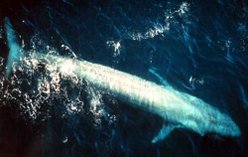Blue Whale
The Blue Whale (Balaenoptera musculus) is a marine mammal belonging to the suborder of baleen whales. Blue Whales are believed to be the largest animal ever confirmed to have lived, at up to 30 metres (100 feet) in length and 140 tonnes (150 short tons) or more in weight. more...
Blue Whales were abundant in most oceans around the world up until the beginning of the 20th century. For the first 40 years of that century they were hunted by whalers almost to extinction. Hunting of the species was outlawed by the international community in 1966. The current world population is about ten thousand individuals, which are located in at least five groups. Before whaling the largest population (202,000 to 311,000) was in the Antarctic but now the largest concentrations are in the North-East Pacific, the Antarctic, and the Indian Ocean, none of which contain more than a few thousand blue whales. There are two groups in the North Atlantic and at least two (possibly more) in the Southern Hemisphere.
Taxonomy and evolution
The Blue Whale is one of seven species of whale in the genus Balaenoptera. DNA sequencing analysis, however, shows that Blue Whales are phylogenetically closer to the Humpback and Gray Whales than other species in its genus. There have been at least 11 documented cases of Blue/Fin Whale hybrid adults in the wild. Aranson and Gullberg (1983) describe the genetic distance between a Blue and a Fin as about the same as that between a human and gorilla. The Balaenoptiidae family is believed to have diverged away from the other families of the Mysticetes suborder as long ago as the middle Oligocene. However, it is not known when the members of these families diverged from each other.
Some authorities classify the species into three subspecies: B. m. musculus, consisting of the north Atlantic and north Pacific populations, B. m. intermedia, the Southern Ocean population and B. m. brevicauda (also known as the Pygmy Blue Whale) found in the Indian Ocean and South Pacific. Some older authorities also list B. m. indica as a further separate subspecies in the Indian Ocean. Unlike the other three subspecies however, this last designation does not have a listing in the Red List of Threatened Species. Both subdivisions are still questioned by some scientists; genetic analysis may yet show there are just two true subspecies..
The specific name musculus is Latin and could mean "muscular", but it can also be interpreted as "little mouse". Linnaeus, who named the species in his seminal work of 1758, would have known this and, given his sense of humour, may have intended the ironic double meaning. Other common names for the Blue Whale have included the Sulphur-bottom, Sibbald's Rorqual, the Great Blue Whale and the Great Northern Rorqual. These names have fallen into disuse in recent decades.
Physical description
The Blue Whale has a long tapering body that appears stretched in comparison with the much stockier appearance of other whales. The head is flat and U-shaped and has a very prominent ridge running from the blowhole to the top of the upper lips. The front part of the mouth is thick with baleen plates; around 300 plates (each one metre long) hang from the upper jaw, running half a metre back into the mouth. Between 60 and 90 grooves (called ventral pleats) run along the throat parallel to the body. These pleats assist with evacuating water from the mouth after lunge feeding (see feeding below).
Read more at Wikipedia.org


